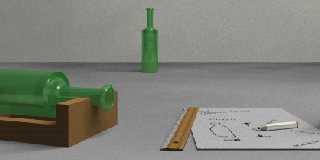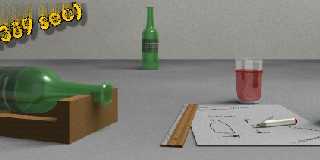 |
 |
|
 |
|
 |
|  |
|  |
|
 |
|
 |
|  |
|  |
|
 |
it is an image to question in p.newusers. but comments are welcome.
Post a reply to this message
Attachments:
Download 'vinebottles.jpg' (34 KB)
Preview of image 'vinebottles.jpg'

|
 |
|  |
|  |
|
 |
|
 |
|  |
|  |
|
 |
nice bottle, like the ruler too.
G
marabou <not### [at] available yet> wrote in message
news:3bdf3b10@news.povray.org...
>
> it is an image to question in p.newusers. but comments are welcome.
> yet> wrote in message
news:3bdf3b10@news.povray.org...
>
> it is an image to question in p.newusers. but comments are welcome.
>
Post a reply to this message
|
 |
|  |
|  |
|
 |
|
 |
|  |
|  |
|
 |
For a so simple shape I would suggest CSG rather than lathe. BTW, are you
using cubic splines (if so, this picture does not show that)? The bottle's
neck looks like you put your control points in such a way that the spline
*falls* into the bottle. I would use a spline editor ;^) ...OR a macro like
the one I'm posting here.
I find it very handy:
simply #declare your array of points and launch the macro as follows:
test_lathe ( type_of_spline, your_array_of_points, sturm_on_or_off), where
type_of_spline can be 1 (linear), 2 (quadratic), 3 (cubic) or 4 (bezier).
Then you can use that same array into make_lathe to quickly edit your lathe
object (just put it in an object block: i.e. object {make_lathe
(t_o_s,y_a_o_p,s_o_o_o) texture { blah blah blah}}).
It will help you to see how things work here (see the two examples
included).
Hope this helps.
--
Jonathan.
Post a reply to this message
Attachments:
Download 'splineformarabou.inc.txt' (4 KB)
|
 |
|  |
|  |
|
 |
|
 |
|  |
|  |
|
 |
-marabou wrote: "but comments are welcome."
Ooops, forgot to say: very nice pic!
--
Jonathan.
Post a reply to this message
|
 |
|  |
|  |
|
 |
|
 |
|  |
|  |
|
 |
such a great thing! i am pleased like a kiddie about that includefile,
Jonathan. now i understand the concept of splines. it is a great tutorial
script! and now i know, why the neck looks ugly: i used cubic_splines and
gave lathe too many control-points in a small area.
now the bottles look much better. and for testing i completely lathed (?)
the vine glass, too. it takes a quarter of time as if it would not be there.
JRG wrote:
> For a so simple shape I would suggest CSG rather than lathe. BTW, are you
> using cubic splines (if so, this picture does not show that)? The bottle's
> neck looks like you put your control points in such a way that the spline
> *falls* into the bottle. I would use a spline editor ;^) ...OR a macro
> like the one I'm posting here.
> I find it very handy:
> simply #declare your array of points and launch the macro as follows:
> test_lathe ( type_of_spline, your_array_of_points, sturm_on_or_off), where
> type_of_spline can be 1 (linear), 2 (quadratic), 3 (cubic) or 4 (bezier).
> Then you can use that same array into make_lathe to quickly edit your
> lathe object (just put it in an object block: i.e. object {make_lathe
> (t_o_s,y_a_o_p,s_o_o_o) texture { blah blah blah}}).
> It will help you to see how things work here (see the two examples
> included).
> Hope this helps.
>
> --
> Jonathan.
Post a reply to this message
Attachments:
Download 'flasche.jpg' (39 KB)
Preview of image 'flasche.jpg'

|
 |
|  |
|  |
|
 |
|
 |
|  |
|  |
|
 |
It's a great improvement!
...But, <looking at a red Chianti wine bottle at the moment>, I think the
neck should be just a little (~1 cm) shorter. The glass textures look a bit
*glowing*, as if you were using too high ambient or diffuse values. I would
use ambient 0 and diffuse ~0 (0.05 is what I usually, well... use). I'd also
use a darker texture for both the green_bottle glass and the wine liquid
(which looks too transparent now). If you're using POV 3.5 (I doubt it,
since you're a Linux guy) or MegaPov try also fresnel reflection and
fade_color.
Keep up the good work.
--
Jonathan.
Post a reply to this message
|
 |
|  |
|  |
|
 |
|
 |
|  |
|  |
|
 |
indeed, i am a linux guy ;-) so, what does fresnel reflection and
fade_color do? is there anything similar in v3.1?
linux users seem not to be loved in pov community <- no v3.5 for linux?
JRG wrote:
> It's a great improvement!
> ...But, <looking at a red Chianti wine bottle at the moment>, I think the
> neck should be just a little (~1 cm) shorter. The glass textures look a
> bit *glowing*, as if you were using too high ambient or diffuse values. I
> would use ambient 0 and diffuse ~0 (0.05 is what I usually, well... use).
> I'd also use a darker texture for both the green_bottle glass and the wine
> liquid (which looks too transparent now). If you're using POV 3.5 (I doubt
> it, since you're a Linux guy) or MegaPov try also fresnel reflection and
> fade_color.
> Keep up the good work.
>
> --
> Jonathan.
Post a reply to this message
|
 |
|  |
|  |
|
 |
|
 |
|  |
|  |
|
 |
marabou wrote:
> indeed, i am a linux guy ;-) so, what does fresnel reflection and
> fade_color do? is there anything similar in v3.1?
> linux users seem not to be loved in pov community <- no v3.5 for linux?
Don't fear, I'm quite sure that when the final release is out it will be a
linux version either. Fresnel reflection uses Fresnel equation in order to
get realistic variable reflections. If you don't want to wait until POV 3.5
is out you can download MegaPov.
As concern fade_color, it's used together with fade_distance and fade_power
(available in POV 3.1) to control light attenuation as it travels through
your objects' interior.
In POV 3.1 you can use it (for instance) as follows: interior { ior 1.5
fade_distance 5 fade_power 2}. In POV 3.5 (and in MegaPov) you can change
the fade_color (in POV 3.1 it is rgb 0 by default).
--
Jonathan.
Post a reply to this message
|
 |
|  |
|  |
|
 |
|
 |
|  |




![]()